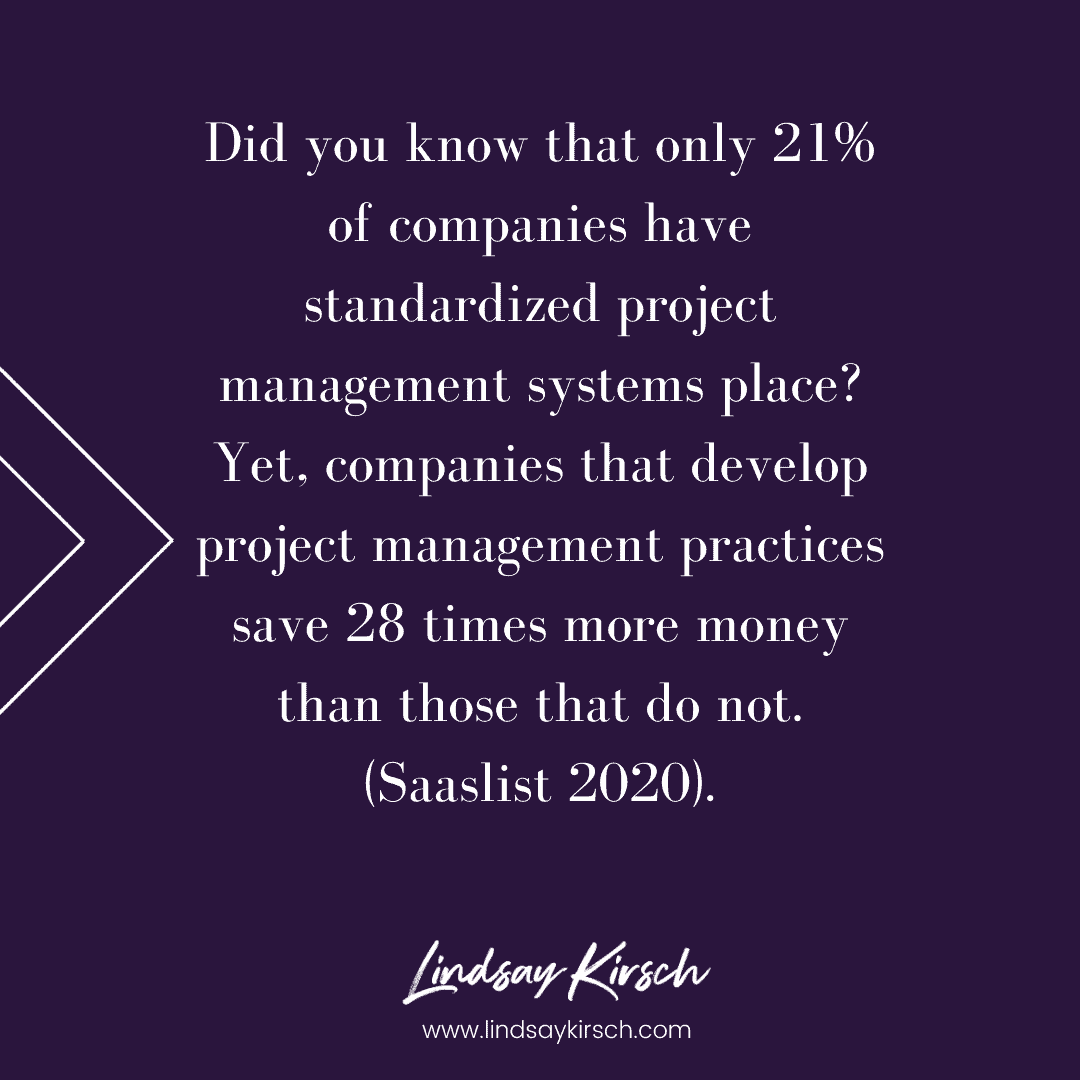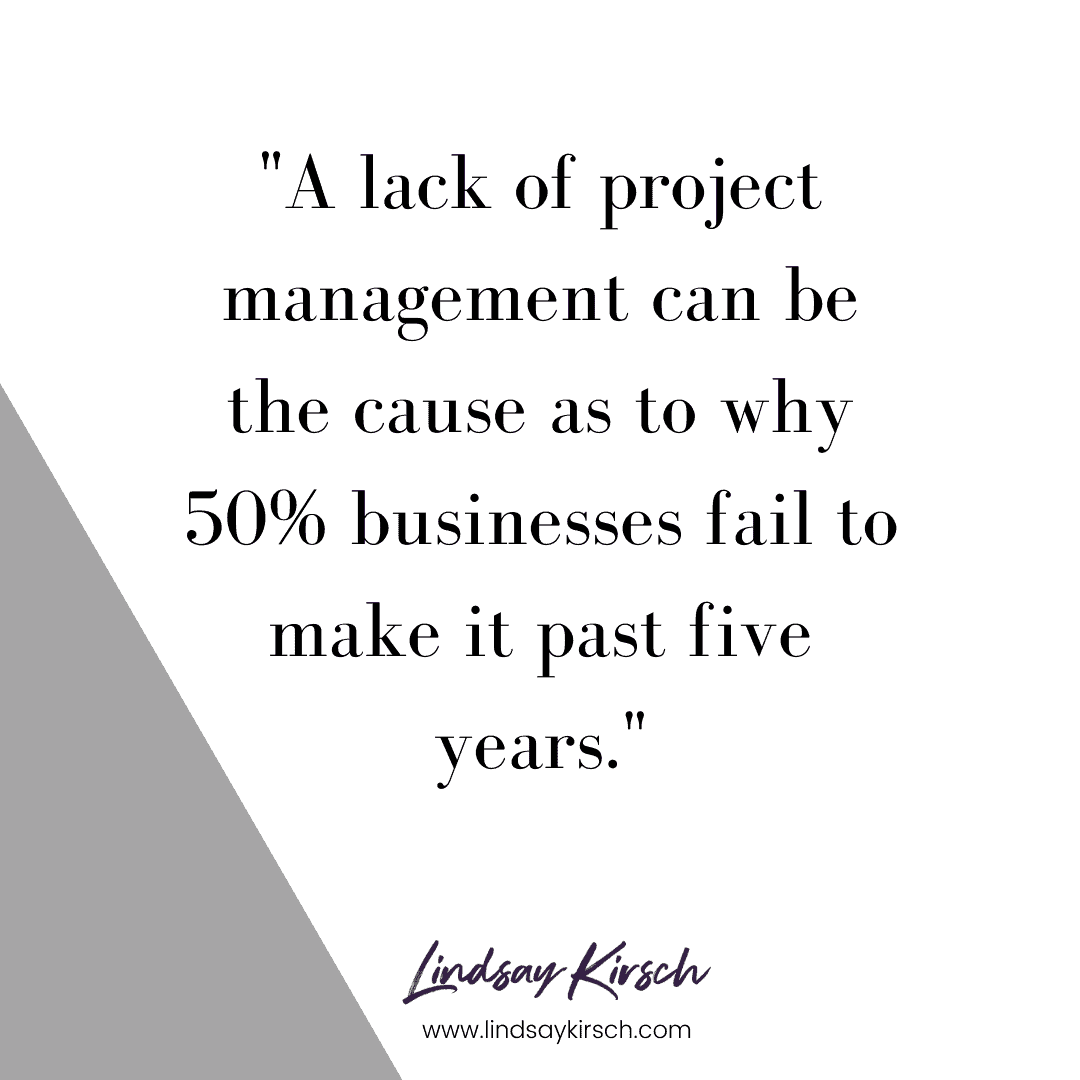Project management is not a task that comes easy for most entrepreneurs; in fact, it can be a thorn in their side.
A lack of project management can be the cause as to why 50% of businesses fail to make it past five years. They don’t know how to prioritize strategy over reactive noisy tasks that eat up time and don’t produce results.
If you don’t have a project management system in place in your organization, this is the place to start!
In this blog, I’ll share with you five key steps to get started with project management for your small business.
What Happens When You Aren’t Managing Projects Properly
A lack of project management tools and strategies in your business can leave you feeling:
- Overwhelmed with everything because you have so many visions in your head.
- Exhausted because it seems like the work is non-stop.
- Confused about what to work on next so you default to what’s making the most noise and not what is necessarily the best strategy.
We all have so many things that we want to accomplish, and yet it seems like there is never enough time to do them all!
(Or, at least that is what we think!)
With so much to do in both our personal and professional lives, it is easy to get caught up in the noise around us and not work on what is going to produce tangible results.
Did you know that only 21% of companies have standardized project management systems place? Yet, companies that develop project management practices save 28 times more money than those that do not. (Saaslist 2020).
Project management is not an option, it’s necessary in order to keep your business on track and driving results.

5 Key Steps to Get Started with Project Management
As a veteran of Project Manager (I’ve been in Project Management for over 15 years!) I have created strategies to manage my projects, keep them on track, and most importantly always know exactly what my team should be working on at any time (including myself).
Step 1: Define Your Projects
To set up a project management strategy, you must define your projects. A project is a temporary endeavor that has a clear beginning and end. It is unique – not a predefined or routine process that is continuous.
Sample projects include: creating a website, writing a book, developing and launching a digital course, and even cleaning your basement!
If you are a serviced based company, you may even consider each client a “project” – depending on the size and definition of the work.
To get started with setting up your Asana workspace, first create a list of all of your projects.
Step 2: Prioritize Your Projects
The next key aspect of managing your projects is to know what the priority of each project is. When you prioritize, you are creating an order of importance around your project. This means, one item must have a higher value than another.
Create priority within your projects. Identify what project is priority #1, #2, #3, and so on.
This is important because when time gets tight, you will need to be able to make a decision on what work to complete. The priority level will help you determine that.
If you need help determining the priority of one project over another, consider the following questions:
- Is the project important or urgent?
- What is the value of the project when completed?
- How much effort will it take to complete?
- What is the cost to complete?
If a project is going to require resources that you do not currently have available, then it cannot be a higher priority than a project that you have resources for right now. Or, if one project is going to create revenue sooner than another, you may want to do that project first to have resources available for another.
A project that has a hard deadline of one month away would need to have a greater priority than one launching in six months. Otherwise, you are going to miss a deadline!
Next to your list of projects, number them from highest priority to lowest.

Step 3: Define Your Tasks
The next step to get started with project management also requires you to look at all of your tasks. A task is a piece of work or unit of work, that must be done to complete a project. A project is made up of multiple tasks and sometimes even subtasks.
If my project is to write a book, my tasks and subtasks may include:

Sometimes, tasks can feel overwhelming because there are SO many of them. It is important to do a thorough brainstorm and try not to miss any tasks.
Personally, I like to break down tasks into 1 hour time increments. By creating a task that will take me about 1 hour to complete makes it easier to schedule into my calendar and allows me to complete more tasks (which is rewarding in itself!)
Next, to your projects, start to think of all the tasks that are associated with this project and write them out.
Step 4: Estimate the Time to Complete
As mentioned above, I like to break down tasks into increments of 1 hour of time. If you don’t choose this method, you will still need to estimate the amount of time the task will take to complete so that you can plan for it.
At most, each task should be broken down into one day of work or less.
We each have our definition of “one day of work”. A day of work is the amount of time that you can spend on this project, each day. If you don’t have time each day to work on tasks, consider designating 1-3 days each week that you can accomplish tasks.
For example, if I can spend one hour per day on my project, my day of work is one hour. Therefore, none of my tasks should be estimated to take longer than 1 hour of work. If they do, I need to break down my task further.
Next, to each one of your tasks, estimate out the time to complete it. Write this number next to the task. If a task is too large for you to complete in your “one day of work,” break it up into smaller sub-tasks that you will be able to complete.
One of my favorite app integrations in Asana is Everhour. Everhour is an all-in-one time tracking system that allows you to track time spent on tasks and projects directly in Asana. Learn more about Everhour here.
Step 5: Schedule Your Tasks
To ensure you execute your project management strategy, give each task a due date, and then schedule the task on your calendar.
I recommend that you schedule your “one day of work time” at the same time every day (or as close to it). This way, you will begin to build a routine of when and where you will be completing your tasks. Scheduling will help with your focus and ultimately enable you to be more productive.
Asana provides a Google calendar integration so that you can layout your tasks due directly into your calendar.
How do you keep up your project management system?
It’s soooo easy to get set up your system, and then slowly forget to keep it up with the business of the workday. This is why scheduling a weekly review, is imperative to your project management system.
Set up a reoccurring weekly appointment to conduct a project review. Work through each project, adjusting tasks and due dates and planning the week ahead. Once you build this habit, you will start to see the direct results in your business.

I’d love to hear more about your project management best practices and tips. Drop them down below so that we can discuss!



